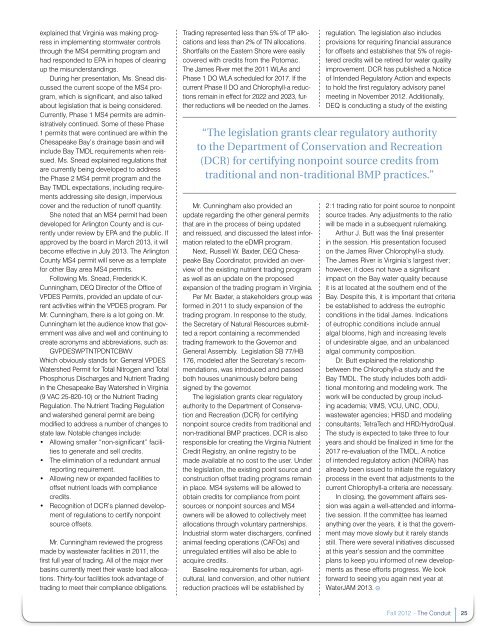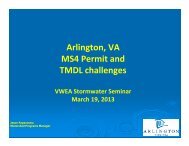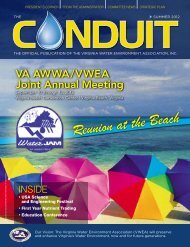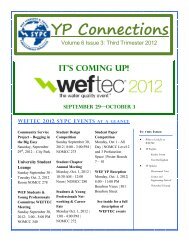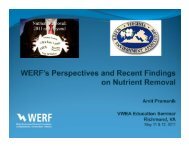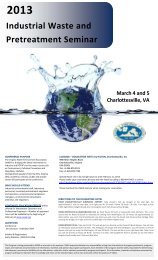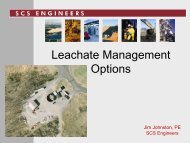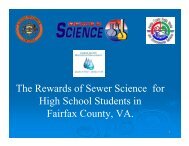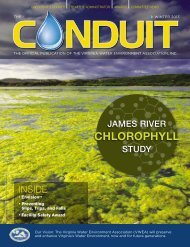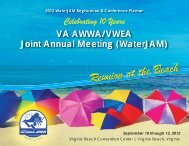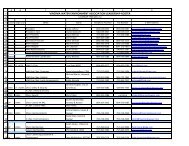bottled vs.tap: - Virginia Water Environment Association
bottled vs.tap: - Virginia Water Environment Association
bottled vs.tap: - Virginia Water Environment Association
- No tags were found...
You also want an ePaper? Increase the reach of your titles
YUMPU automatically turns print PDFs into web optimized ePapers that Google loves.
explained that <strong>Virginia</strong> was making progressin implementing stormwater controlsthrough the MS4 permitting program andhad responded to EPA in hopes of clearingup the misunderstandings.During her presentation, Ms. Snead discussedthe current scope of the MS4 program,which is significant, and also talkedabout legislation that is being considered.Currently, Phase 1 MS4 permits are administrativelycontinued. Some of these Phase1 permits that were continued are within theChesapeake Bay’s drainage basin and willinclude Bay TMDL requirements when reissued.Ms. Snead explained regulations thatare currently being developed to addressthe Phase 2 MS4 permit program and theBay TMDL expectations, including requirementsaddressing site design, imperviouscover and the reduction of runoff quantity.She noted that an MS4 permit had beendeveloped for Arlington County and is currentlyunder review by EPA and the public. Ifapproved by the board in March 2013, it willbecome effective in July 2013. The ArlingtonCounty MS4 permit will serve as a templatefor other Bay area MS4 permits.Following Ms. Snead, Frederick K.Cunningham, DEQ Director of the Office ofVPDES Permits, provided an update of currentactivities within the VPDES program. PerMr. Cunningham, there is a lot going on. Mr.Cunningham let the audience know that governmentwas alive and well and continuing tocreate acronyms and abbreviations, such as:GVPDESWPTNTPDNTCBWVWhich obviously stands for: General VPDES<strong>Water</strong>shed Permit for Total Nitrogen and TotalPhosphorus Discharges and Nutrient Tradingin the Chesapeake Bay <strong>Water</strong>shed in <strong>Virginia</strong>(9 VAC 25-820-10) or the Nutrient TradingRegulation. The Nutrient Trading Regulationand watershed general permit are beingmodified to address a number of changes tostate law. Notable changes include:• allowing smaller “non-significant” facilitiesto generate and sell credits.• the elimination of a redundant annualreporting requirement.• allowing new or expanded facilities tooffset nutrient loads with compliancecredits.• recognition of DCR’s planned developmentof regulations to certify nonpointsource offsets.Mr. Cunningham reviewed the progressmade by wastewater facilities in 2011, thefirst full year of trading. All of the major riverbasins currently meet their waste load allocations.Thirty-four facilities took advantage oftrading to meet their compliance obligations.Trading represented less than 5% of TP allocationsand less than 2% of TN allocations.Shortfalls on the Eastern Shore were easilycovered with credits from the Potomac.The James River met the 2011 WLAs andPhase 1 DO WLA scheduled for 2017. If thecurrent Phase II DO and Chlorophyll-a reductionsremain in effect for 2022 and 2023, furtherreductions will be needed on the James.regulation. The legislation also includesprovisions for requiring financial assurancefor offsets and establishes that 5% of registeredcredits will be retired for water qualityimprovement. DCR has published a Noticeof Intended Regulatory Action and expectsto hold the first regulatory advisory panelmeeting in November 2012. Additionally,DEQ is conducting a study of the existing“The legislation grants clear regulatory authorityto the Department of Conservation and Recreation(DCR) for certifying nonpoint source credits fromtraditional and non-traditional BMP practices.”Mr. Cunningham also provided anupdate regarding the other general permitsthat are in the process of being updatedand reissued, and discussed the latest informationrelated to the eDMR program.Next, Russell W. Baxter, DEQ ChesapeakeBay Coordinator, provided an overviewof the existing nutrient trading programas well as an update on the proposedexpansion of the trading program in <strong>Virginia</strong>.Per Mr. Baxter, a stakeholders group wasformed in 2011 to study expansion of thetrading program. In response to the study,the Secretary of Natural Resources submitteda report containing a recommendedtrading framework to the Governor andGeneral Assembly. Legislation SB 77/HB176, modeled after the Secretary’s recommendations,was introduced and passedboth houses unanimously before beingsigned by the governor.The legislation grants clear regulatoryauthority to the Department of Conservationand Recreation (DCR) for certifyingnonpoint source credits from traditional andnon-traditional BMP practices. DCR is alsoresponsible for creating the <strong>Virginia</strong> NutrientCredit Registry, an online registry to bemade available at no cost to the user. Underthe legislation, the existing point source andconstruction offset trading programs remainin place. MS4 systems will be allowed toobtain credits for compliance from pointsources or nonpoint sources and MS4owners will be allowed to collectively meetallocations through voluntary partnerships.Industrial storm water dischargers, confinedanimal feeding operations (CAFOs) andunregulated entities will also be able toacquire credits.Baseline requirements for urban, agricultural,land conversion, and other nutrientreduction practices will be established by2:1 trading ratio for point source to nonpointsource trades. Any adjustments to the ratiowill be made in a subsequent rulemaking.Arthur J. Butt was the final presenterin the session. His presentation focusedon the James River Chlorophyll-a study.The James River is <strong>Virginia</strong>’s largest river;however, it does not have a significantimpact on the Bay water quality becauseit is at located at the southern end of theBay. Despite this, it is important that criteriabe established to address the eutrophicconditions in the tidal James. Indicationsof eutrophic conditions include annualalgal blooms, high and increasing levelsof undesirable algae, and an unbalancedalgal community composition.Dr. Butt explained the relationshipbetween the Chlorophyll-a study and theBay TMDL. The study includes both additionalmonitoring and modeling work. Thework will be conducted by group includingacademia; VIMS, VCU, UNC, ODU,wastewater agencies; HRSD and modelingconsultants; TetraTech and HRD/HydroQual.The study is expected to take three to fouryears and should be finalized in time for the2017 re-evaluation of the TMDL. A noticeof intended regulatory action (NOIRA) hasalready been issued to initiate the regulatoryprocess in the event that adjustments to thecurrent Chlorophyll-a criteria are necessary.In closing, the government affairs sessionwas again a well-attended and informativesession. If the committee has learnedanything over the years, it is that the governmentmay move slowly but it rarely standsstill. There were several initiatives discussedat this year’s session and the committeeplans to keep you informed of new developmentsas these efforts progress. We lookforward to seeing you again next year at<strong>Water</strong>JAM 2013.Fall 2012 – The Conduit25


